| Ragnheidur Jónsdóttir |
 |
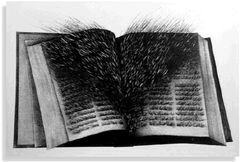 |
|
|
by Adalsteinn Ingólfsson
Symbols for Messages
Ove the past ten years, Icelandic graphics developed into an independent art genre. For more than half a century, painting and sculpture largely dominated the art scene in Iceland, but thanks to participation at outstanding foreign graphics exhibition (French, American, Polish and Scandinavian), and to a new generation of graphic artists schooled abroad, activity in their field has been lively and increasingly apprectiated by the public.
The membership of the Icelandic graphics association, Íslensk Grafík, today stands at 30, with the work being done in this line involving most of the internationally popular techniques: copper engraving, aquatint, drypoint, lithography, linocut, woodcut, silkscreen and lately even mezzoting.
The numer of prints ranges from 30 to 60, and the price spread is from 500 to 1,600 Icelandic krónur.
The many prizes and distinction brought home from graphics exhibitions around the world - from Yugoslavia, France, South America and Poland - testify to the new standing of the genre in Iceland. Among the more active as participant at international shows is Ragnheidur Jónsdóttir, who has won important prizes for her prints. Her achievement is all the more remarkable if it is taken into account that she is a busy mother of five, and that she did not begin to work seriously in the medium until the end of the 1960s. She is very preoccupied with social issues, commenting on them without hesitation in her prints, short of sacrificing the essential artistic discipline; that is, she realizes that a picture must be a thought-out, formal composition if it is to serve for delivering a message.
Like so many other artists, Ragnheidur goes about her work by creating assorted personal symbols, which are often relevant to social questions such as the plight of women today and interference by the state with the natural course of the arts (both very real issues in Iceland). These symbols, however, are powerful enough to convey broader meaning; the condition of women through the ages around the whole world and the efforts of states from time immemorial to control art for their own purposes.
All of Ragnheidur’s prints reveal a steady concern with the freedom of the individual, particularly as regards creative artists. In her early work, this is expressed through a half-abstract style where hard, geometric forms meet softer ones that commonly suggest human limbs, and it always seems that the ‘living’ elements are dominated somehow by the powerful geometry in the pictures: packed, sealed, handed over, unfree.
These effects became progressively stronge as the years passed during the 1970’s, with Ragnheidur’s techniques developing correspondingly. Her soft, ‘living’ forms became more easily identifiable: pillows tied onto steel grating, flowers placed against inhuman spearlike structures that give the impression of modern prisons; next, the flower images show up again in groups - as huge, almost trembling, beings vibrant with energy and subdued eroticism, rulers of earth where lower orders of life crawl. But on occasion such organic forms assume a more menacing guise in Ragnheidur’s works, usually in combination with her symbols of official power: chairs or thrones. The change in the soft elements is immediately noticeable; they are no longer open and living, but hemmed in, shrivelled or bloated - flown up onto their thrones like ill-tempered insects; to make the point absolutely clear, Ragnheidur places them in familiar settings, even ones known to most Icelanders. When politicians in Reykjavik made a clumsy attempt to win control over the municipal galery, Kjarvalsstadir, Ragnheidur commented on the development by means of a picture showing these fearsome ‘insects’ sitting on high-backed chairs inside the art centre, lording it with ther ugly appearance. Nevertheless, that work of hers is powerful enough to extend the focus from local politics to a wider context of similar nature.
But chairs can be used in many ways. A famous print by Ragnheidur entitled ‘October 24’ and paying homage to Icelandic women’s general strike on that day in 1975, displays a row of strange chairs in the foreground, with a mass of women behind them. Tied onto each chair is an apron that seems about to be blown away, perhaps due to the newfound energy of the women’s liberation movement. This preumably signifies that the women are forging ahead, rejecting their traditional roles and occupying the seats of power to establish balance. Occasionally, Ragnheidur’s symbolism is ambiguous. How are we to interpret her memorable picture of the pregnant dress og a chair? - a work well known to many in Scandinavia through touring exhibitions of Icelandic graphics. It is certain enough that the artist levels her sights on the stereotyped notion of woman as a dressed-up doll whose primary role is to give birth to children. The woman is shown as deprived of personality. But is she tied for good onto the chair? - the symbol of male dominton - or does the chair mean that she is actually close to a position of power? The viewer is left confused, but stimulated into thought.
Ragnheidur’s latest series of graphics involves variations on the book as a theme. In her hands, the book, a highly valued object in Iceland, undergoes amazing metamorphoses: pages are folded out to reveal how grass sprouts from what is printed, a haystack comes to light under a page, a feather hovers above the book - an indirect reference to the old writing quill - and some stranger matters are found on occasion in this set of pictures. Pages are rolled up, wreathed and covered with grass/hair, giving a striking impression of female genitalia. What a brilliant idea, come to think of it. After all, the most powerful descriptions of human sex life are found in books.
Such qualities account for the impressive range of Ragnheidur Jónsdóttir’s graphics. She is able to create symbols of elegant form which, at the same time, are magnets for the intellect.
Grafik Nytt, no. 2, 1982.
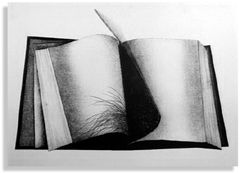 |
|
|
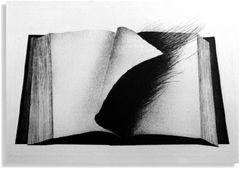 |
|
|
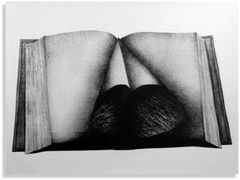 |
|
|
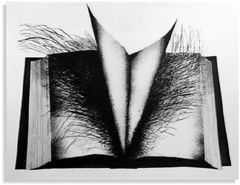 |
|
|
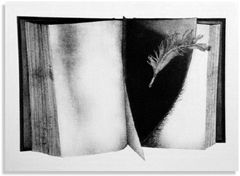 |
|
|
|
|
|
|
|
|
|
|